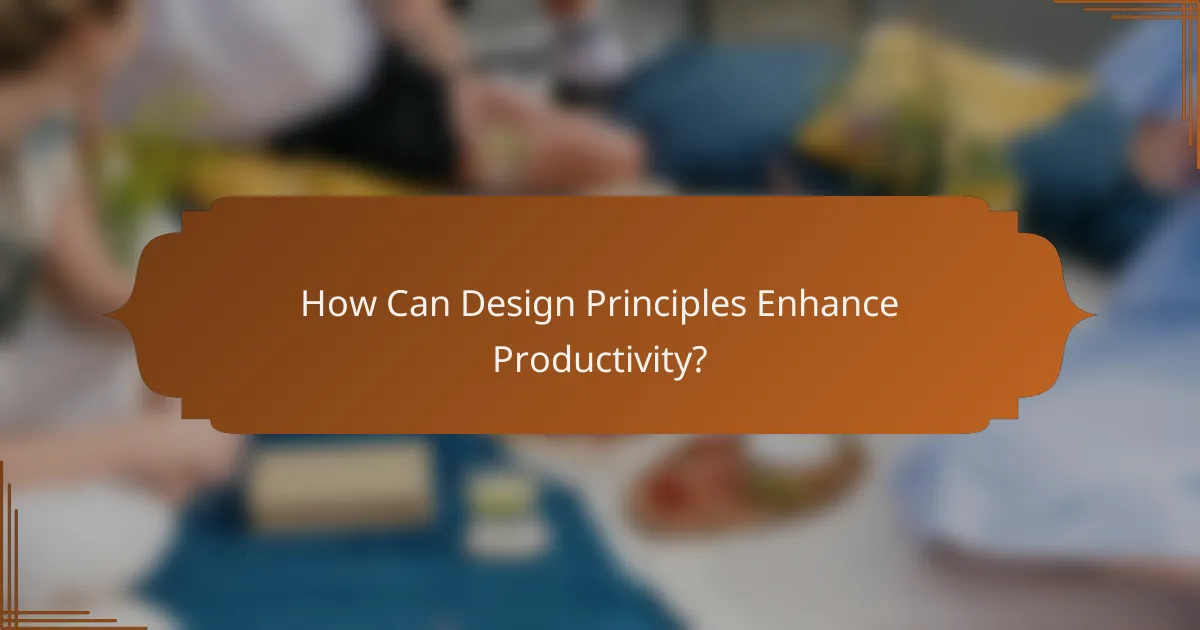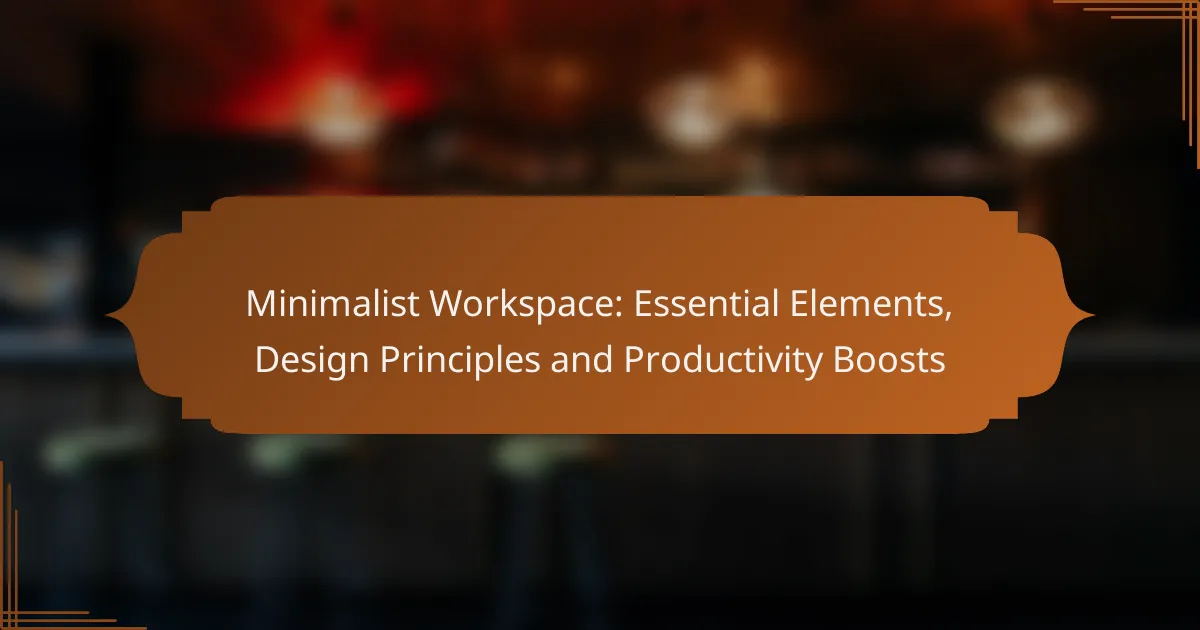A minimalist workspace emphasizes simplicity and functionality, creating an environment that fosters productivity. By incorporating essential elements such as decluttered surfaces, functional furniture, and natural lighting, individuals can enhance their focus and workflow. Adopting design principles that prioritize ergonomics and efficient layout further minimizes distractions, allowing for a more effective work experience.

What Are the Essential Elements of a Minimalist Workspace?
A minimalist workspace focuses on simplicity and functionality, incorporating essential elements that enhance productivity. Key components include decluttered surfaces, functional furniture, natural lighting, a neutral color palette, and minimal decor, all aimed at creating an efficient and calming environment.
Decluttered surfaces
Decluttered surfaces are vital for maintaining focus and reducing distractions. Clear desks and work areas allow for better organization and a more serene atmosphere. Aim to keep only necessary items on your workspace, such as a computer, a notepad, and a few essential tools.
To achieve this, regularly assess what items are truly needed and consider storage solutions like drawers or boxes to keep non-essential items out of sight. A good rule of thumb is to limit visible items to five or fewer to maintain a clean look.
Functional furniture
Functional furniture is designed to support productivity without unnecessary embellishments. Choose pieces that serve multiple purposes, such as a desk with built-in storage or an ergonomic chair that promotes good posture. This approach not only saves space but also enhances comfort during long working hours.
When selecting furniture, prioritize quality and durability over trendy designs. Investing in a few well-made items can lead to long-term satisfaction and improved work efficiency.
Natural lighting
Natural lighting is crucial for creating a pleasant workspace that boosts mood and productivity. Exposure to natural light can enhance focus and reduce eye strain, making it easier to work for extended periods. Whenever possible, position your desk near windows to maximize daylight.
If natural light is limited, consider using full-spectrum bulbs that mimic daylight. This can help maintain a bright and inviting atmosphere, especially during darker months.
Neutral color palette
A neutral color palette promotes a calm and distraction-free environment. Shades like white, beige, gray, and soft pastels can create a cohesive look that enhances concentration. Avoid bold colors that may be visually overwhelming or distracting.
When choosing colors, consider the psychological effects of different hues. For example, blues and greens are known to promote tranquility, while yellows can stimulate creativity. Aim for a balanced mix that suits your personal preferences and work style.
Minimal decor
Minimal decor emphasizes simplicity and intentionality in design. Select a few decorative items that inspire or motivate you, such as artwork or plants, while avoiding clutter. This approach helps maintain focus and creates a visually appealing space without overwhelming the senses.
When incorporating decor, opt for pieces that reflect your personal style but remain functional. For instance, a small plant can improve air quality and add a touch of nature without taking up much space. Keep decor to a minimum, ideally limiting it to three items or fewer on your desk or shelves.

How Can Design Principles Enhance Productivity?
Design principles can significantly enhance productivity by creating an environment that minimizes distractions and maximizes efficiency. By focusing on elements such as layout, ergonomics, and designated work zones, individuals can improve their focus and workflow.
Open space layout
An open space layout fosters collaboration and communication, which can lead to increased productivity. When designing such a space, consider the balance between openness and privacy; too much openness can create distractions, while too much separation can hinder teamwork.
To optimize an open layout, use furniture that encourages interaction, such as communal tables or lounge areas. Additionally, incorporating plants and natural light can enhance the overall ambiance, making the workspace more inviting and stimulating.
Ergonomic design
Ergonomic design is crucial for maintaining comfort and reducing fatigue during long work hours. This includes selecting adjustable chairs, desks at appropriate heights, and equipment that minimizes strain on the body.
Investing in ergonomic accessories, such as keyboard trays and monitor stands, can improve posture and reduce the risk of musculoskeletal issues. Regular breaks and stretching exercises should also be encouraged to maintain physical well-being and enhance productivity.
Task-oriented zones
Creating task-oriented zones helps to streamline workflow by designating specific areas for different activities, such as focused work, collaboration, and relaxation. This organization can reduce time spent transitioning between tasks and enhance concentration.
When designing these zones, consider the needs of the team and the types of tasks performed. For example, a quiet zone for deep work should be equipped with soundproofing elements, while collaborative spaces can include whiteboards and flexible seating arrangements to facilitate brainstorming sessions.

What Are the Best Practices for Implementing Minimalism?
Implementing minimalism in your workspace involves focusing on essential elements that enhance functionality while reducing clutter. Key practices include starting with a clean slate, incorporating multifunctional items, and limiting distractions to boost productivity.
Start with a clean slate
Begin by decluttering your workspace to create a clean slate. Remove all non-essential items, keeping only what you truly need for your daily tasks. This process helps to clear your mind and allows for better focus on your work.
Consider organizing your items into categories: keep, donate, or discard. Aim for a workspace that feels open and inviting, which can enhance your overall productivity. A clean desk can significantly reduce stress and improve your ability to concentrate.
Incorporate multifunctional items
Choose furniture and tools that serve multiple purposes to maximize efficiency in a minimalist workspace. For example, a desk with built-in storage can reduce the need for additional cabinets, while a comfortable chair can double as a meeting space.
Look for technology that combines functions, such as a printer-scanner-copier, to minimize the number of devices you need. This approach not only saves space but also simplifies your workflow, making it easier to stay organized.
Limit distractions
To maintain a minimalist workspace, it’s crucial to limit distractions that can hinder productivity. This includes reducing visual clutter by keeping only essential items on your desk and using cable management solutions to hide cords.
Consider implementing digital minimalism as well. Organize your computer desktop and limit notifications from apps and emails to focus better on your tasks. Set specific times for checking messages to avoid constant interruptions, which can significantly enhance your work efficiency.

How Does Minimalism Affect Mental Clarity?
Minimalism enhances mental clarity by reducing distractions and simplifying the environment. A clean, organized workspace allows for better focus and decision-making, leading to improved productivity.
Reduces stress
A minimalist workspace minimizes clutter, which can significantly lower stress levels. When your environment is tidy and free from unnecessary items, it creates a calming atmosphere that promotes relaxation and reduces anxiety.
To achieve a stress-free workspace, consider decluttering regularly. Keep only essential items on your desk and store away anything that does not serve a purpose. Aim for a workspace that feels open and inviting, which can help you feel more at ease while working.
Improves focus
By eliminating distractions, minimalism fosters greater concentration. A streamlined workspace allows you to direct your attention to the task at hand, making it easier to enter a state of flow.
To enhance focus, limit visual distractions such as excessive decorations or multiple screens. Use tools like noise-canceling headphones or focus apps to maintain your concentration. Regularly assess your workspace to ensure it remains conducive to focused work.

What Are the Top Minimalist Workspace Products?
The top minimalist workspace products focus on functionality, simplicity, and enhancing productivity. Key items include standing desks, ergonomic chairs, and essential organizational tools that promote a clean and efficient work environment.
Standing desks
Standing desks are a popular choice in minimalist workspaces as they encourage movement and better posture. These desks can be adjusted to various heights, allowing users to switch between sitting and standing throughout the day, which can help reduce fatigue and improve focus.
When selecting a standing desk, consider factors such as stability, ease of adjustment, and surface area. Many models range from around $200 to $800, depending on features like electric height adjustment or built-in storage. It’s essential to choose a desk that fits your workspace and personal preferences.
To maximize the benefits of a standing desk, alternate between sitting and standing every 30 to 60 minutes. Ensure your monitor is at eye level and your keyboard is positioned to maintain a neutral wrist posture. Avoid common pitfalls like standing for too long without breaks, which can lead to discomfort.
